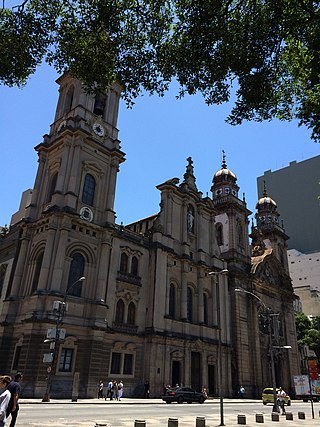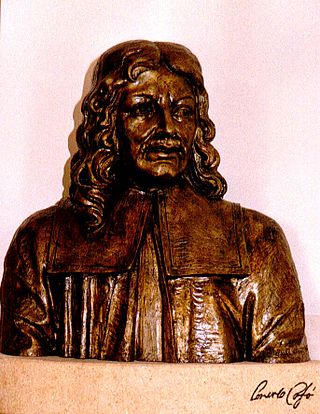
Whitefriar Street Carmelite Church is a Roman Catholic church in Dublin, Ireland maintained by the Carmelite order. The church is noted for having the relics of Saint Valentine, which were donated to the church in the 19th century by Pope Gregory XVI from their previous location in the cemetery of St. Hippolytus in Rome.

Żurrieq is a town in the Southern Region of Malta. It is one of the oldest towns in the country, and it has a population of 11,823 inhabitants as of March 2014. Żurrieq is one of the 10 parishes to be documented in 1436 and it is dedicated to Saint Catherine. The island of Filfla is administratively a part of the town. The town stretches from Nigret to Ħal Far. In old times the town was had a border with Żejtun. The village of Qrendi used to be part of the parish of Żurrieq until 1618 when it was made into its own parish.

St John's Co-Cathedral is a Catholic co-cathedral in Valletta, Malta, dedicated to Saint John the Baptist. It was built by the Order of St. John between 1573 and 1578, having been commissioned by Grand Master Jean de la Cassière as the Conventual Church of Saint John.

Naxxar is a town and local council in the Northern Region of Malta. The population in March 2014 was 14,891. The Naxxar Church is dedicated to Our Lady of Victories. The annual village feast is celebrated on 8 September. It formerly hosted the Maltese International Trade Fair at Maltese International Trade Fair Grounds.

Our Lady of Mount Carmel, or Virgin of Carmel, is the title given to the Blessed Virgin Mary in her role as patroness of the Carmelite Order, particularly within the Catholic Church. The first Carmelites were Christian hermits living on Mount Carmel in the Holy Land during the late 12th and early to mid-13th century. They built in the midst of their hermitages a chapel which they dedicated to the Blessed Virgin, whom they conceived of in chivalric terms as the "Lady of the place." Our Lady of Mount Carmel was adopted in the 19th century as the patron saint of Chile.

The Old Cathedral of Rio de Janeiro dedicated to Our Lady of Mount Carmel is an old Carmelite church which served as cathedral (Sé) of Rio de Janeiro from around 1808 until 1976. During the 19th century, it was also used successively as Royal and Imperial Chapel by the Portuguese Royal Family and the Brazilian Imperial Family, respectively. It is located in the Praça XV square, in downtown Rio. It is one of the most important historical buildings in the city.

Maltese architecture has its origins in prehistory, and some of the oldest free-standing structures on Earth – a series of megalithic temples – can be found on Malta. The islands were colonized by the Phoenicians and later the Romans, who established the cities of Melite and Gaulos. Although these were substantial settlements and are known to have had numerous temples, churches and palaces, few remains have survived apart from some architectural fragments.

The Metropolitan Cathedral of Saint Paul, commonly known as St Paul's Cathedral or the Mdina Cathedral, is a Catholic cathedral in Mdina, Malta, dedicated to St. Paul the Apostle. The cathedral was founded in the 12th century, and according to tradition it stands on the site where Roman governor Publius met St. Paul following his shipwreck on Malta. The original cathedral was severely damaged in the 1693 Sicily earthquake, so it was dismantled and rebuilt in the Baroque style to a design of the Maltese architect Lorenzo Gafà between 1696 and 1705. The cathedral is regarded as Gafà's masterpiece.

Lorenzo Gafà (1639–1703) was a Maltese Baroque architect and sculptor. He designed many churches in the Maltese Islands, including St. Paul's Cathedral in Mdina and the Cathedral of the Assumption in Victoria, Gozo. He was the younger brother of the sculptor Melchiorre Cafà.

Aylesford Priory, or "The Friars" was founded in 1242 when members of the Carmelite order arrived in England from Mount Carmel in the Holy Land. Richard de Grey, a crusader, sponsored them, and conveyed to the order a parcel of land located on his manor in Aylesford in Kent. The estate came back into the ownership of the Carmelite order in 1949. After refurbishment, which revealed 15th century remnants, the manor house was Grade I listed in 1959. After subsequent work on site, the 15th century gatehouse and the NE section of the wall were also Grade I listed on 25 February 1987. The priory now contains an array of contemporary artworks by notable artists. It is a pilgrimage destination of national significance.

The Church of St. John in Aix-en-Provence, situated at the corner of rue d'Italie and rue Cardinale, is a Gothic Roman Catholic church, the first in Provence. It was built in the 13th century, mostly in the 1270s.

The "Sanctuary of Our Lady of Mount Carmel", better known as Carmine Church, is a Roman Catholic church in Via Porta Imperiale, Messina, Sicily. It replaces the former church, which was razed by the 1908 Messina earthquake. Located close to the Tribunal, the Carmine Church was rebuilt in 1930 in the eighteenth century Baroque or Rococo style. Designed by the architect Cesare Bazzani, the church was reconsecrated on 15 July 1931.

The Basilica of Our Lady of Mount Carmel is a Carmelite Roman Catholic minor basilica dedicated to Our Lady of Mount Carmel, located in Valletta, Malta. It is one of the major churches of Valletta, and it forms part of a UNESCO World Heritage Site which includes the entire city. The present church was constructed between 1958 and 1981 on the site of a late 16th century church which was destroyed during World War II.

The Church of the Nativity of Mary is a Roman Catholic baroque parish church located in Naxxar, Malta.

The church of Our Lady of Mount Carmel and St Simon Stock is a Roman Catholic church at 41 Kensington Church Street, Kensington, London W8, served by Discalced Carmelites.

The Parish Church of Our Lady of Mount Carmel, or simply known as the Carmelite Church or Balluta Parish Church, is a neo-gothic Roman Catholic parish church located in Balluta Bay in the town of St Julian's, Malta.

St. Catherine's Old Church, also known as St. Gregory's Church, is a Roman Catholic church in Żejtun. The church and its complex sit towards the outskirts of the town, commanding views over Marsascala Bay, St. Thomas' Bay and Marsaxlokk harbour. The church is colloquially known as Saint Gregory's due to a traditional procession held on the first Wednesday following Easter Sunday. Its dedication to Catherine of Alexandria dates back to an original chapel on this site, which was one of the eight mother churches on Malta. The church stands next to the three cemeteries of Żejtun, dedicated to St. Rocco, St. Gregory and St. Catherine. The church's functions as the parish church of Żejtun were taken over by a new parish church, also dedicated to St. Catherine, and designed by Lorenzo Gafà.

The Parish Church and Sanctuary of Our Lady of Graces is a Roman Catholic parish church in Żabbar, Malta, dedicated to Our Lady of Graces. The church was originally built between 1641 and 1696 to designs of the Renaissance architect Tommaso Dingli. Its façade, an outstanding example of Maltese Baroque architecture, was built in 1738 to designs of Giovanni Bonavia. The dome was rebuilt in the early 19th century after it had been damaged during the French blockade of 1798–1800, and it was rebuilt again in the first half of the 20th century to designs of Giuseppe Pace.

The Church and Convent of Our Lady of Mount Carmel is an 18th-century Roman Catholic church in Cachoeira, Bahia, Brazil. It was constructed between 1688 and likely completed in 1773. The church is dedicated to Our Lady of the Rosary and is constructed in the Baroque style with a Rococo frontispiece. The church opens to Travessa Taváres, a broad avenue, with a view to the Paraguaçu River. The church is dedicated to Our Lady of Mount Carmel.
Pietro Paolo Troisi was a Maltese Baroque silversmith, sculptor, medallist, designer, engraver and Master of the Mint. His works include bronze sculptures of his patron António Manoel de Vilhena, designs of various coins and medals, a wide range of mainly religious works in silver, engraved portraits, designs for temporary triumphal arches and designs for works in a number of churches, most notably the altar of repose at the Mdina cathedral.






















